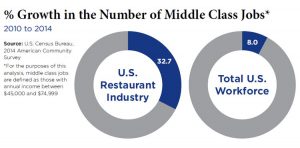High employment rates for culinary professionals
Contact: Katie Glass, Executive Director of Marketing/Public Information Officer
Phone: 608.822.2411
Mail: 1800 Bronson Blvd., Fennimore, WI 53809
Date of Release: August 23, 2016
Wisconsin Restaurants Strive to Get More Cooks in the Kitchen
Fennimore, WI -Erin Eagan, WTCS
Jeff Dombeck, SWTC Culinary Instructor
It’s been a long road back, but the hospitality industry nationwide has seen a big resurgence in great paying jobs. The opportunities are available to anyone with some training and a desire to experience this fast-paced, exciting industry. With so many new and expanding food service facilities in the areas of restaurants, hotels/resorts, catering and healthcare, the culinary industry has been facing a surplus of job openings. That has lead to a shortage of managers, chefs, caterers, bakers and cooks to fill them.
It is widely accepted that employment recovery in the United States began in March 2010. From that point to the end of 2015, nearly 2 million jobs were added by restaurants (according to the Bureau of Labor Statistics). Clearly, the hospitality industry is the driving force behind the nation’s economic recovery.
Between 2010 and 2014, jobs within the food service industry that had annual incomes of between $45,000 and $74,999 increased by 32.7 percent. In contrast, there was only an 8 percent growth of total jobs in the economy with salaries in the same range.
The shortage is felt keenly here in Wisconsin. In the next 10 years, the Wisconsin Restaurant Association expects 26,000 jobs will need to be filled in the state’s $8.4 billion food service industry. So what can be done to fill these positions?
Jeff Dombeck and Karen Bast, instructors in the culinary programs at Southwest Wisconsin Technical College believe that the answer lies in a connection between the industry as a whole and the training programs offered by Southwest Tech. “There should be a direct pipeline”, says Dombeck, “between our institution and the employers in southwest Wisconsin. However, there are a lot of businesses that aren’t as attuned to the culinary programs as maybe they could be if we just reached out to each other.”
Karen Bast thinks that a partnership works on the recruitment end as well. “I believe that there are a lot of entry-level employees that would consider some training in culinary arts or culinary management”, Bast says, “if given just a little push by their employers.”
For the businesses that are connected, however, Bast says it’s a cooperative effort that produces results. “We’ve got great relationships with many employers, and those employers recruit on our campus,” she explains. “When they send us students and we send them graduates, it’s a win-win situation.”
For anyone interested in entering the culinary field, the ongoing shortage all but guarantees immediate employment upon completion of a degree. “The key is that we offer all of our students the hands-on training that they need and put them in real world situations so that they are ready for a good paying job immediately after graduation,” says Dombeck. “Some of our students have even started their own business right after graduation, which is almost unheard of.”
Further proof is offered by The Wisconsin Technical College System. According to a recent survey, 95% of 2015 culinary graduates were employed within six months of graduation as executive chefs, sous chefs, line cooks as well as restaurant managers. Median entry-level wages for Culinary Management graduates is $31,822 annually, while the starting median annual wages for Culinary Arts grads is $25,270. These culinary grads are often snatched up before the ink even dries on their diplomas. For these individuals, dedication and loyalty are often rewarded by an industry that tends to promote from within.
“With salaries for experienced culinary professionals rising into the six-figure range in certain areas of the country, the future for our students is unlimited,” Bast explains. “Having a degree will definitely get you there faster.”

